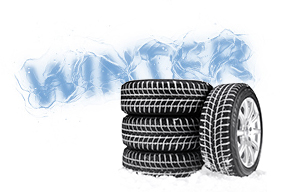Congratulations! You’ve taken the first step in winter safety and decided to invest in a set of winter tires. There are a few things you are going to want to remember about your winter tires, especially if this is your first time making the transition. A few things you may want to know:
- Depending on the kind of tires you select, you may notice a change in the feel/sound of your commute. Because winter tires have more of a grip on the road, they might sound louder depending on your vehicle. If you notice it at all, don’t panic. You are only hearing the added contact. If you add studs or chains to the mix, the sound will increase as well, and you may feel as if you are driving an armored tank down the road. Keep in mind, that’s just the sound of traction, and you’re going to be thankful you’ve got that in the event of a winter storm during your drive.
- They aren’t for all conditions. Once the weather warms up, you’ll have to part with your tires until the next year. Warm weather can actually damage winter tires because the rubber is softer. If left on during warmer months, they will wear down faster and could even cause safety issues. Winter tires should not be pushed to their maximum speed, either. Increased speed increases heat which contributes to additional wear and damage. Although if it’s cold, slick, or snowy outside, slow down for your safety and the safety of other drivers.
- Tighten your lug nuts. You should be doing this anytime you get your tires rotated or switched out. The initial tightening will loosen over the first few days. Typically, you can tighten them yourself with just one good rotation, or you can usually stop back into your automotive shop or tire shop and get them re-adjusted. Not only will it help you maintain proper alignment and balance without wobbling or pulling, it will prevent you from losing your tires.
- Drive safe! Just because you have added a good amount of grip to your tires, don’t become over-confident. Take it easy. You’ll learn that you may be able to maintain a more normal speed with your winter tires, but don’t turn that into your own winter race track. Winter tires have limits too. Slips, slides, and skids can still happen with any safety measures being taken. Pay attention to your driving, the road, and other drivers. Ultimately, a safer tire won’t do much if you throw out all other safety precautions.
- Watch your pressure. We aren’t referring to your job, your family, or your winter gas bill. Keep an eye on your tire pressure. Fluctuating temperatures will change your tire pressure, and that is a fact. Understand your tire’s specific rating and make sure to monitor your tires when they haven’t been sitting for days or driven on for hours. Both warmer and cooler weather will determine you tire pressure. Just make sure you aren’t under-inflating or over-inflating, as these will both cause premature wear to your winter tires.


